Aloe veras are famous for being durable plants. Their ability to produce a gel-like substance rich in medical properties makes them famous. Aloes will get infested if conditions are made favorable for the bugs.
Prolonged dampness, hot and humid climates, and extremely dry conditions are common reasons aloe vera gets infested by bugs. The common bugs are mealybugs, aphids, scales, and aloe mites. Using rubbing alcohol, neem oil, or insecticidal soaps is an excellent way to eliminate these bugs.
There are many things to know when it comes to bug infestation. This guide will provide you with a list of the types of bugs, their reason for attack, identification, symptoms, and ways of dealing with them.
So, sit back and read this article till the end to know how to make your aloe vera a bug-free plant.
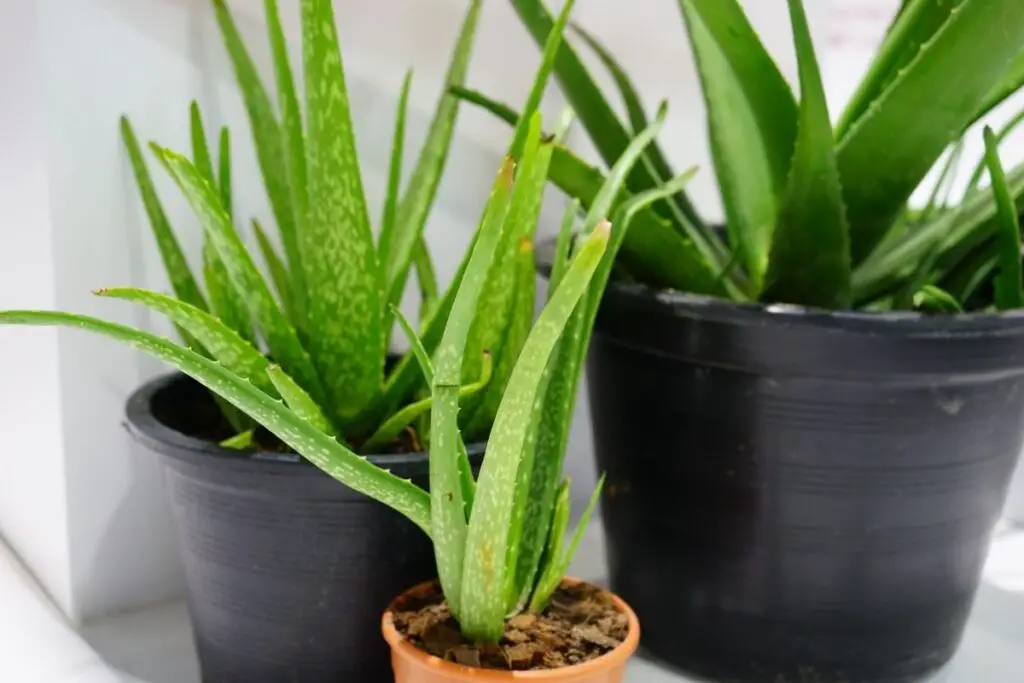
What bugs are attracted to aloe vera plants?
It doesn’t matter whether your plant is outside or inside.
If the conditions are not favorable for them, Aloes will get attacked by bugs.
Many bugs can attack the plant. Below is a list:
- Aphids
- Scales
- Mealybugs
- Aloe mites
- Spider mites
- Fungus gnats
- Fruit flies
- Snout beetles
Aphids on aloe vera
Aphids enjoy cold, damp weather.
If they constantly get such conditions, they will even lay eggs.
If your aloe vera plant stays damp and cold for a long time along with insufficient sunlight, aphids will like to make it their home.
These tiny bugs suck the plant sap, thus making the plant weak and discolored.
They enjoy feeding on the new leaves and flower spikes.
The new leaves are still younger and softer than the mature leaves.
They also release a sticky substance called honeydew.
Identification
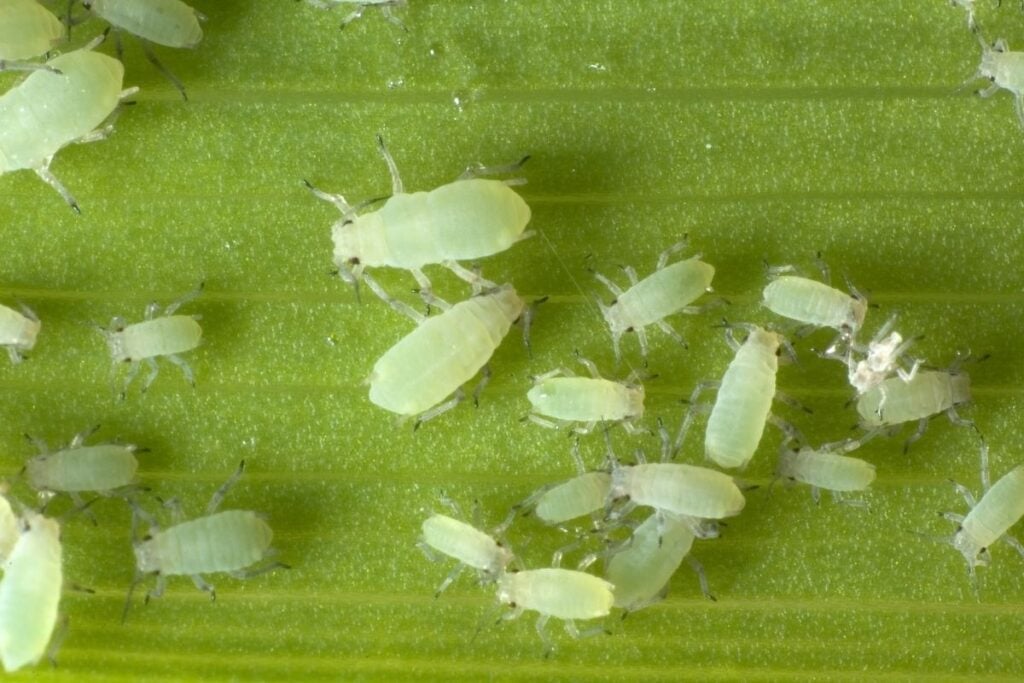
- Green, yellow or black
- Measures 1/8 inch in length
- Found mainly under the leaves
- They have fat, pear-shaped bodies
Symptoms of infestation
- Discolored leaves
- The leaves have a sawdust-spread look.
- Sticky leaves due to excretion of honeydew.
- The presence of aphids indicates that your plant has been overwatered.
How to eliminate?
- Isolate the plant. It is easy for the potted plants, not for the in-ground plants.
- Release ladybugs to the planting site. They will kill and feed on all the aphids, thus making your plant pest-free.
- You can dab a cotton ball in rubbing alcohol and apply it to the infected area. It will make them fall off the plant and kill them.
- Spray Neem oil that has pyrethrin. Pyrethrin-based insecticides can kill aphids. Additionally, Neem oil is safe to use. Mix 1-2 tablespoons of oil with 8 cups of water. Mix and spray.
- Do not expose the plant to full sun while treating with neem oil. Do it at night if possible.
- Use soapy water. Add a few drops of liquid soap with 1-2 cups of water: mix and spray.
- You can also use insecticidal soaps like Castile soap or Safer soaps. If the infestation is too much, the last option is to use other chemical pesticides.
Scales on aloe vera
Scales enjoy a warm and dry environment.
Aloe vera also enjoys such weather.
But if your aloe vera is kept dehydrated for a long time under the sun, scales will attack the plant.
Though the plant likes to stay in dry and warm weather, you should not keep it under extremely dry conditions for a long time.
Scales remain alive by sucking the sap from the plant tissues.
If they enjoy their present location, they will hatch eggs and won’t move from that particular location.
Identification
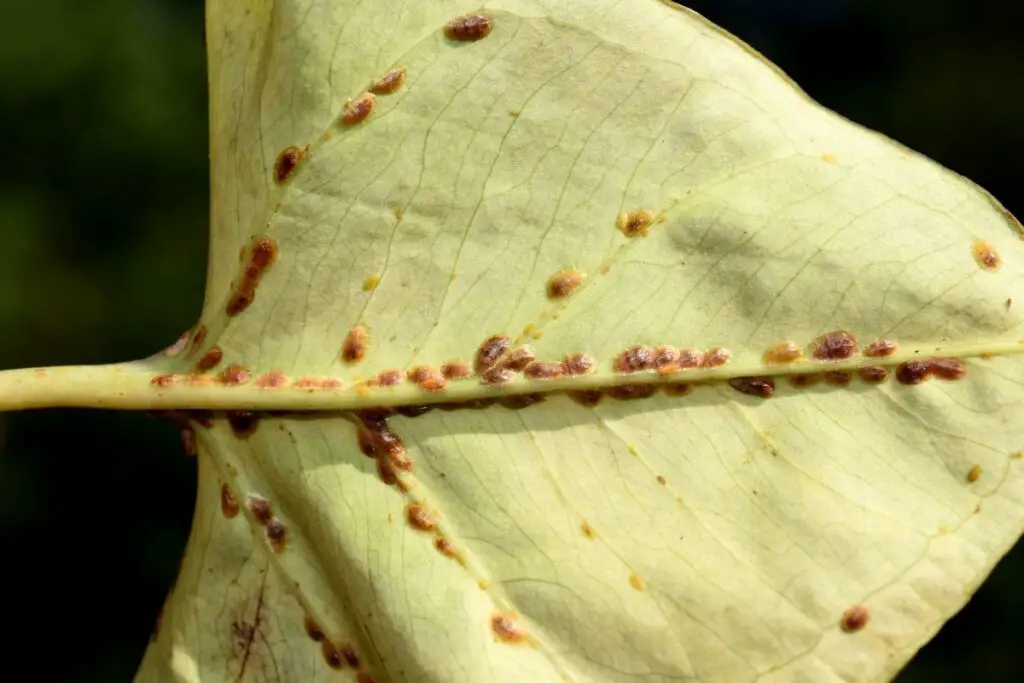
- They have a flat and waxy brown body
- They measure only ¼ inches
- The mature scales stay in the same place once settled
- They are found at any part of the aloe vera leaf
Symptoms
- Yellow plant tissues with scab-like creation.
- Stunted growth
- Brown bumps all over the leaves
- The soft-bodied scales too release honeydew, thus making the leaves sticky.
How to get rid of them?
- Release ladybugs. They will feed on the soft-bodied scales.
- For the hard-shelled scales, dab 70% solution of rubbing alcohol on the infected area. It will weaken their shell and kill them.
- Use your fingernail or tweezers to remove the brown bumps.
- Mix a few drops of insecticidal soaps with 2 cups of water. Shake and spray well to the infected parts.
Looking for gardening supplies? We have tested 100's of products before recommending them to you guys. Check out our best pick below:
| Image | Gardening Supplies | Best Price? |
|---|---|---|
 Top
Top Top
Top | Raised Garden Bed Kit | Check On Amazon |
 | XLUX Soil Moisture Meter, Plant Water Monitor, Soil Hygrometer Sensor for Gardening, Farming, Indoor and Outdoor Plants, No Batteries Required | No Results |
 Top
Top Top
Top | 82 Pcs Garden Tools Set and Extra Succulent Tools Set | Check On Amazon |
 | Joeys Garden Expandable Garden Hose with 8 Function Hose Nozzle, Lightweight Anti-Kink Flexible Garden Hoses, Extra Strength Fabric with Double Latex Core, (50 FT, Black) | No Results |
 Top
Top Top
Top | Dual Chamber Compost Tumbler | Check On Amazon |
 Top
Top Top
Top | Sunnyglade Plant Stakes | Check On Amazon |
 Top
Top Top
Top | Organic Cold Pressed Neem Seed Oil | Check On Amazon |
 Top
Top Top
Top | Mighty Mint Gallon :-Insect and Pest Control Peppermint Oil | Check On Amazon |
 Top
Top Top
Top | Scotts DiseaseEx Lawn Fungicide | Check On Amazon |
 Top
Top Top
Top | Jacks Classic 20-20-20 All Purpose Fertilizer | Check On Amazon |
 Top
Top Top
Top | 30,000 Seeds Pollinator Attracting Wildflower Mixture | Check On Amazon |
 Top
Top Top
Top | Survival Vegetable Seeds Garden Kit-Over 16,000 Seeds | Check On Amazon |
White scales on aloe vera
These are similar to scales, only white in color.
Identification
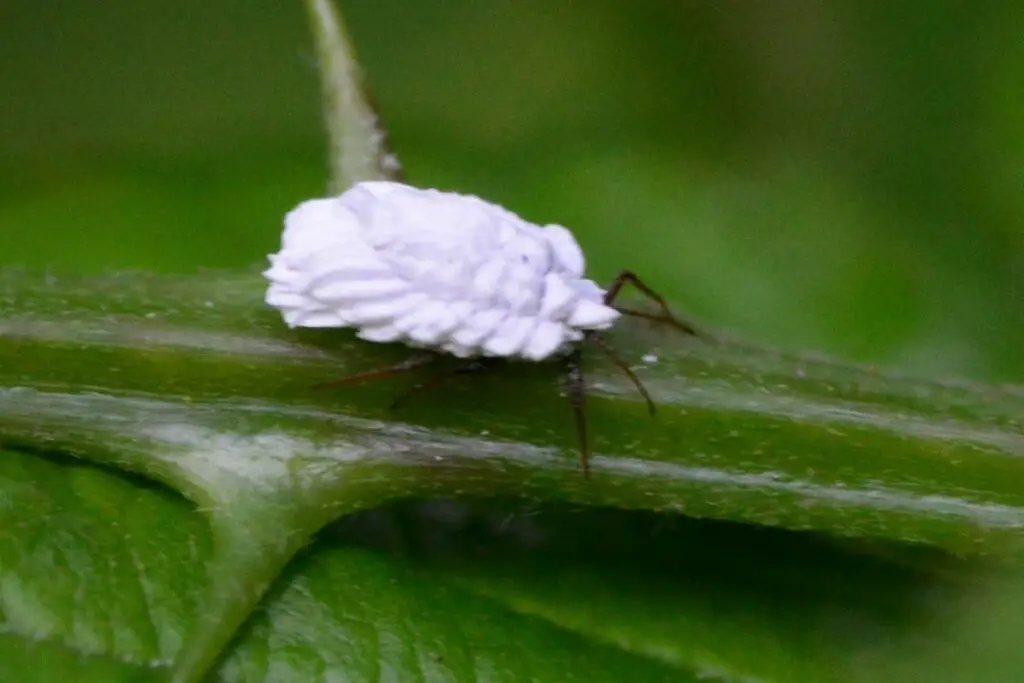
- Grey color
- Measures only 1 to 2 mm
- They have a coin-size body shape
- The infected area looks like white dust
Symptoms
- It covers the upper leaves more than the other areas
- Feeding on the upper leaves makes the plant suffer a lack of sunlight which can further deteriorate the plant’s health.
- They don’t move for their place once they settle. It seems as if insecticides don’t have any effect on them.
How to remove them?
- Shower the plant with a strong jet of water.
- Apply a soapy water solution, a few amounts of methylated spirits, or cooking oil.
- You can also apply commercial insecticides to kill them.
Mealybugs on aloe vera
These are somewhat similar to scales.
But they are covered with white waxy bodies.
Mealybugs suck the sap\ of the Aloe vera by piercing the plant’s tissues.
Slowly, the plant will become weak and die.
Your aloe veras have mealybugs because they are too drawn to plants will high sap content.
They are also attracted to prolonged damp conditions.
Your plant will have mealybugs if you overwater them.
Identification
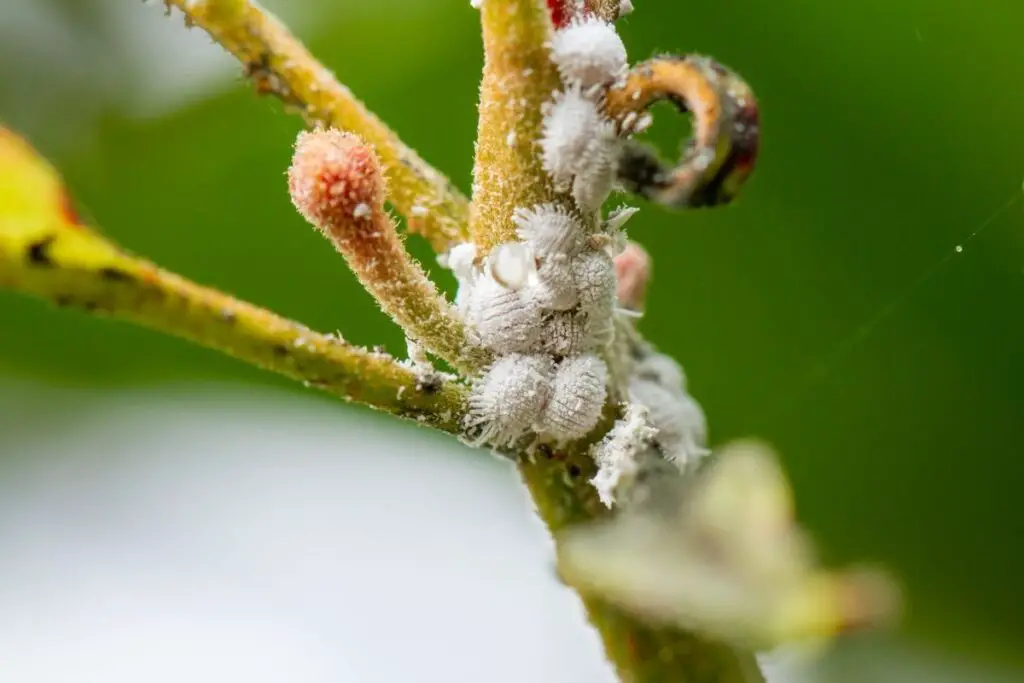
- White bugs with a wax coating.
- Difficult to see due to their small, tiny size.
- Mealybugs measure around 2 to 3 mm.
- Found mostly below the leaf base.
Symptoms
- The leaves will have white cottony marks.
- Sticky leaves due to the excretion of honeydew.
- Stunted growth
- Yellow distorted leaves
How to remove them?
- Shower the plant with lukewarm soapy water (2 teaspoons with one-gallon water).
- You can dab alcohol directly over the infected area with 70% solution to weaken their wax coating.
- Use insecticidal soaps like Safer soaps and Castile soaps. Mix a few drops of it with 2 cups of water, shake well, and spray.
- Use Neem oil to keep your plant safe from all harmful pesticides. Mix some neem oil with liquid soap and water, mix well and spray. Do it at night as spraying neem and exposing the plant to sunlight can burn it.
- If the infestation is heavy, you have to isolate the plant to avoid spreading and use chemical pesticides and insecticides to treat the problem.
Aloe mites on aloe vera
Aloe mites are also called aloe wart mites or gall mites.
These mites are generally Eriophyid mites that feed on most succulents, especially aloe veras.
They are present in your aloe vera plant because they might have got spread by winds, water, insects, birds, and people.
You cannot notice their infestation unless there is the formation of galls, a cancerous growth.
Identification
- Resemble worms with two pairs of legs
- Slow crawlers
- It goes unnoticed until the cancerous growth starts.
- They measure less than 0.25 mm.
Symptoms
- Frilly growth in the flower stalk, developing into galls.
- Bubble fringes on the edges of the leaves
- An abnormal orange or green growth from the joining of the leaves and stems
- Crooked flower clusters and distorted leaves
- These galls result in irregular growth near the base of the older leaves.
- The bumpy growths are due to the saliva the insects produce into the plant tissues while feeding.
How to fix it?
This cancerous growth in the plant is very much difficult to treat.
If they are spread too much, it will be impossible to revive the plant.
However, if you spot the gall growth and take immediate steps, you can save the plant from dying.
- First and foremost, you have to isolate the plant, whether it is in the pot or the ground. They can spread faster and even catch other healthy plants.
- One of the easy and effective methods is to remove the distorted leaves and discard them. Use a sharp disinfected knife to make a clear cut so that no portion of this gall growth stays in the plant. Let the cut portion form callous for some days.
- If there are multiple galls present, apply insecticide during the spring by drenching the roots. Some examples are Carbaryl, Orthene, and Dimethoate. These products can control mite infestation. The systemic application encourages the insecticides to get through the mites and the galls.
- If most of the leaves are damaged, you need to throw the plant away. The best way to protect the plant from this problem is through prevention.
Spider mites on aloe vera
Spider mites enjoy a plant with high nitrogen levels, phosphorus, and carbohydrates in the leaves.
They like dry, warm temperatures around 85°F and 60% of humidity.
Aloes enjoy temperatures around 55 to 80°F and low humidity levels around 40%.
Since aloes thrive best in a dry and warm climate, there are chances of spider mites attacking the plant.
The infestation chances increase when the aloes receive high humidity levels.
Identification
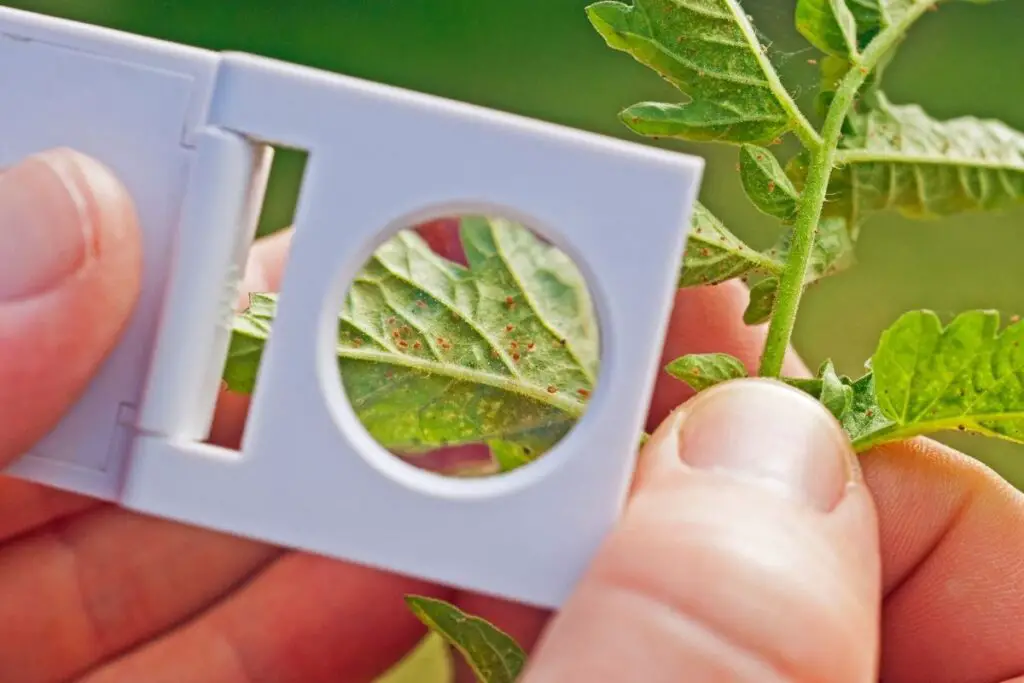
- They measure only 1mm. Difficult to spot.
- Their eggs are translucent and small.
- They are found on the underside of the leaves.
- The leaves will have red or black moving marks. Red ones are the most common mites.
Symptoms of damage
- Silvery and white spots all over the leaves
- The tips, edges, and joining part of the leaves and stem have webs. Spider mites make these webbings for easy movement.
- Discolored leaves, flowers, and emerging flower stalks.
How to fix it?
- Shower the plant very well. Spider mites hate wet conditions and will start leaving your plant after showering it.
- Spray Neem oil on the infected location. Don’t expose the plant to the direct sun while treatment. Or else, do it at night. Otherwise, the direct sun can burn the plant.
- Dab rubbing alcohol with a cotton ball over the infected areas.
- They enjoy hot and dry weather but hate wet weather. Use this as an advantage. Water the plant well and never keep it bone-dry. Always water them when the 2-3 inches are dry.
- Use insecticidal soaps to remove and kill them.
- If the infestation has increased too much, use chemical miticides and pesticides to remove them.
Fungus gnats on aloe vera
Fungus gnats attack your aloe vera due to overly wet soil.
They enjoy staying in overwatered plants.
Their larvae feed on the roots of the plant and affect its growth.
They will even attack the plant if any decayed materials are present in the plant.
Identification
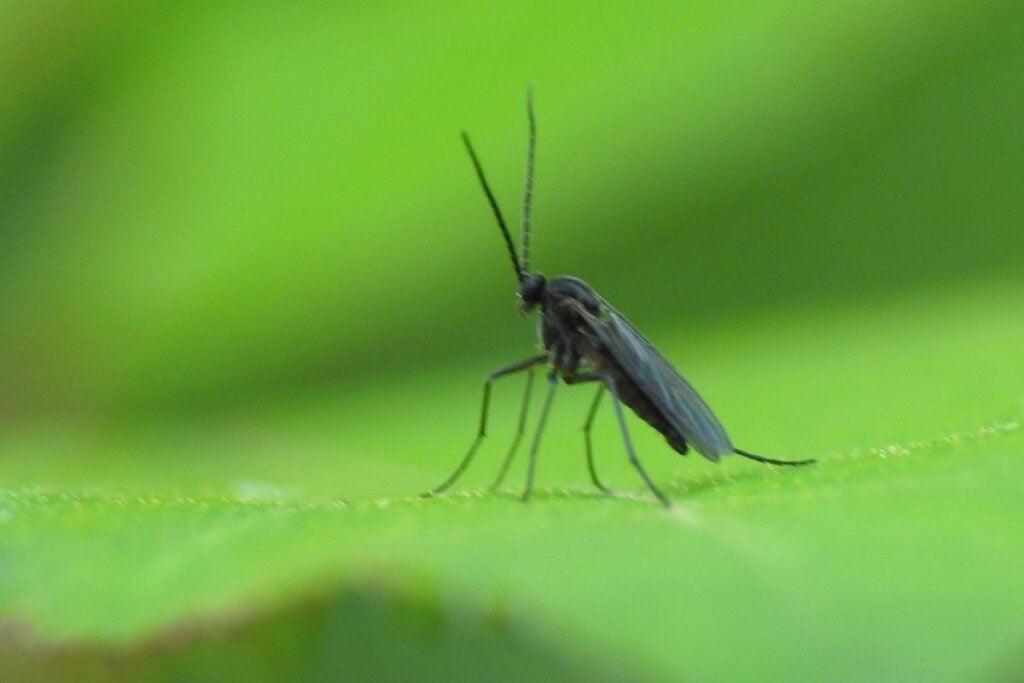
- The adults are black and brown, resembling mosquitoes.
- The larvae look white and transparent with shiny heads.
- They look like small white maggots.
- They come out at night from the soil and loiter around the plant.
Symptoms
- The adults don’t do any damage. Their presence is a sign of overwatering.
- Sudden discoloration of the leaves despite proper care and maintenance.
- Too much infestation can make them susceptible to diseases.
How to fix the problem?
- Use sticky cards to trap them.
- Use 1 part of 3% hydrogen peroxide with four parts of water and soak the soil with it when it is time for watering. This solution will eliminate the adults, larvae, and eggs from the plant and soil.
- For prevention, use well-drained soil, a terra cotta container, and water only when the soil gets dry. Keep the soil dry most of the time.
- Remove the damaged and dead leaves before they fall off and start decaying.
Fruit flies on aloe vera
Many people confuse fruit flies with fungus gnats due to their look.
But there is a difference between the two.
Fungus gnats are mainly black, but fruit flies are reddish-brown.
They will only attract aloe veras if the plant is near fruits, vegetables, or garbage disposals.
Except for the fruits and vegetables, fruit flies will also wander about if your plant has organic debris in the soil.
How to remove the fruit flies?
- Replace the soil your plant is standing over now. You can easily do it with potted plants.
- In the case of in-ground ones, transplant the aloes to a different location
- The soil must be well-drained so that the water doesn’t stand for long.
- Do not overwater the plant. They enjoy dry conditions. Overwatering will also encourage the presence of these bugs.
- You must remove the dead leaves from the plant before they fall off and become debris or decayed organic matter.
- Use sticky trap cards to catch them. The color of the cards will attract them and make them stick to the card.
- You can use vinegar. Take a bowl and add some vinegar, some drops of soap, and some water. Cover it with plastic with a hole at the top and place it near the plants. The odor of the vinegar will attract them, and once they drop into the mixture, they cannot come out of it.
Snout beetles on aloe vera
These infect all the aloes and those succulents that look like aloes.
The outdoor plants get attacked more than the indoor ones.
Identification
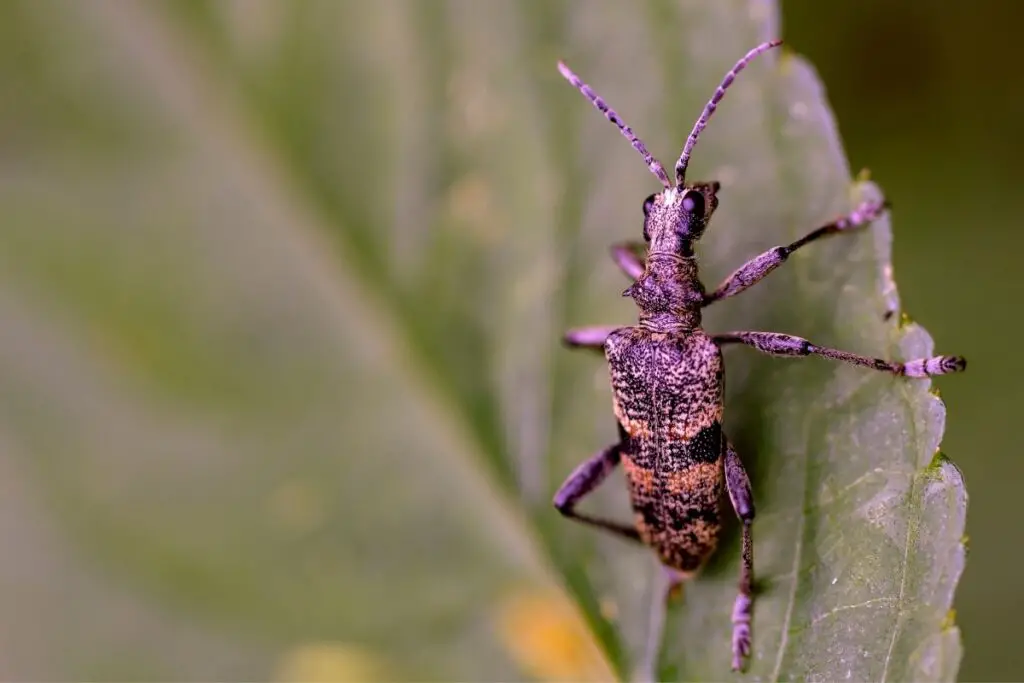
- It measures only ¾ inches in length.
- Their eggs are found at the base of the plant.
- Their antenna have elbow-shape
- Generally being 5-segmented tarsi, they appear 4-segmented due to the tiny size of the fourth segment.
- Their larvae are white or cream-colored with legless, cylindrical, and C-shape.
Symptoms
- The leaves have pea-shaped dark spots, which eventually turn into dry spots. These are marks of their piercing when they suck the saps of the leaves.
- The larvae enter the plant tissues and damage them, resulting in rotten stems.
- Distorted leaves due to chewing and piercing.
How to solve the issue?
- You can remove the mature beetles with hand tweezers. The larvae are difficult to deal with as they enter the plant tissues.
- Insecticides or pesticides will work if the larvae have not stayed in the plant for a long time. Their distance from the middle part of the plant and the boreholes can tell you how long they have stayed in your plant.
- If the infestation is too much, cut off the infected stalks above the infestation. Cut off until no boreholes are seen.
- Try systemic insecticide application for further prevention.
Final thoughts
An aloe vera fed and watered well will be able to resist bug infestation more than a weak plant. Ensure that the plant receives enough sunlight, water, fertilizer, and temperature.
Many bugs enjoy extremely dry and humid climates and wet and cold climates. Use these points as an advantage to solve the problem.
Try to keep aloe veras dry but hydrated. Water them only when the top 2-3 inches have dried. Don’t let the aloe veras get exposed to high humidity. It must stay within 30-40% or below.
You will need a magnifying glass to identify the type of bug that attacked your plant and then treat it as required.
However, you can also get a hint about it by the signs of damage. You can always use neem oil as the first option for treatment. It is organic and safe.
Note that insecticidal soaps are made for killing plant pests. They are not like household detergents. So, don’t simply apply the detergents to the plant. That might give rise to serious issues.
Reference: Wikipedia.

I need some advice on what to do for my aloe Vera plants that I sprayed STEM BUG SPRAY on the top of my soil to kill the gnats, since then my aloe stems are leaning over and wanting to detach from the base of the plant.
Did I just accidentally kill my Aloe Vera plants myself???
Please help me save my Aloe plants with any suggestions or help or tips!!!
Thank you Dee!!!
Oh so sorry to hear that, it sounds like your Aloe Vera plants may have been affected by the stem bug spray. It’s possible that the chemicals in the spray may have caused damage to the plants, leading to the stems leaning over and potentially detaching from the base of the plant.
To help save your Aloe plants, here are a few tips:
Remove the affected stems: If the stems are already leaning over and appear to be dying, it may be best to remove them from the plant. This will help prevent any further damage from spreading to the rest of the plant.
Repot the plant: If the stem bug spray has caused damage to the soil, it may be best to repot the plant in fresh soil. Make sure to use a well-draining soil mix that is specifically designed for succulents like Aloe Vera.
Provide proper care: Aloe Vera plants require bright, indirect sunlight and well-draining soil. Make sure to water the plant only when the soil is completely dry, and avoid overwatering as this can lead to root rot.
Use natural pest control methods: Instead of using chemical-based pest control methods, consider using natural alternatives such as neem oil or insecticidal soap. These methods are safer for your plants and the environment.
I hope these tips help you save your Aloe Vera plants!